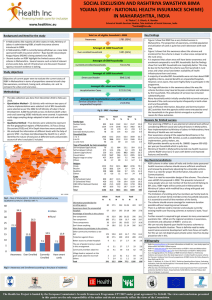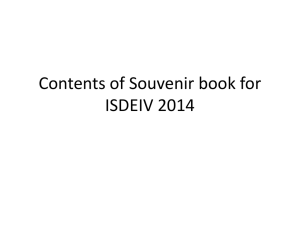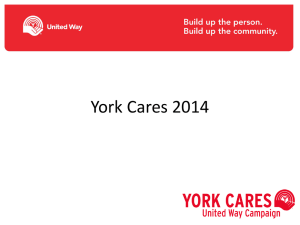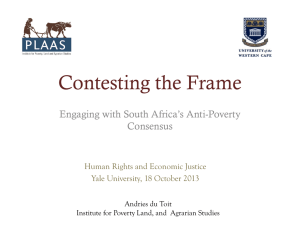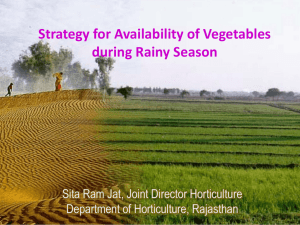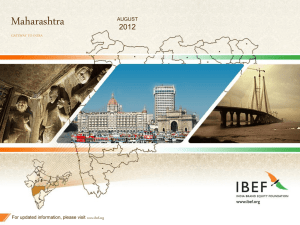Rural Poverty Scenario Maharashtra
advertisement
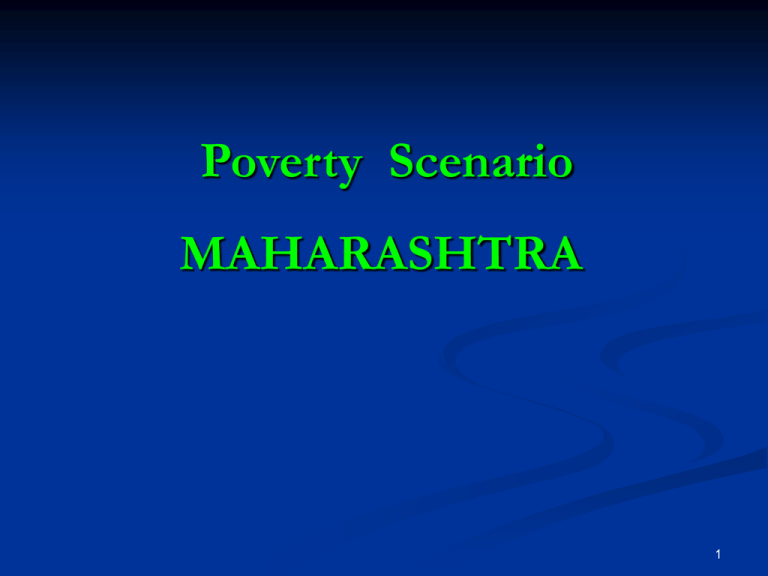
Poverty Scenario MAHARASHTRA 1 POVERTY Affront to Human Dignity Cost to Economy & Polity Create Vulnerability & Dependence Consequences • • • • • Non-inclusive growth social unrest instability unproductive manpower perpetuation of poverty Solution • IRDP, SGSY, NRLM, ?, ?, ? • No more experimentation POVERT / NRLM = PROSPERITY • For each village, every villager 2 ‘POVERTY’ speaks for itself P - Population O - Occupation V - - SC/ST/OBC. - Landless, Labor, Artisans, Marginal rain fed farmers, Lowly Service provider. Vulnerability - infant mortality, early marriages, ill health, Malnutrition, child labour. E - Education - Illiteracy, dropouts, unemployability. R - Resources - Credit, skills, tools, raw material, livelihood access. T - Traditions - Superstitions, practices, taboos, Customs Y - Yield - Low productivity, No-growth, peripheral market. 3 Maharashtra Salient Features Salient Features Area : Population (2001 Census) Rural Urban Total Rural Households Rural Habitations Villages GPs Average population of GP 1000 to 60000 5000 to 10000 Rainfall 3.08 lakh sq. km. : : : 5.57 crore (57.7 million) 4.10 crore (41 million) 9.67 crore (96.7 million) : : 125 lakh (12.5 million) 98000 : : 42500 27920 : 2000 : : 389 1360 : from 300 - 6000 mm 4 POVERTY STATISTICS • Rural BPL population : : Comprising of 45 lakh families 2.05 crore Villagers ST SC NT/ND/VJ/SBC OBC Others 10.80 lakh (60 lakh population) 8.50 lakh (40 lakh population) 5.00 lakh (25 lakh population) 14.70 lakh (60 lakh population) 6.00 lakh (24 lakh population) : : : : : According to NSSO data Maharashtra should have around 1.75 Cr. Rural peolple (31% of rural population) & around 40 lakh rural families. 5 District wise position (2002) as per report of Human Develop0ment Commission District Per capita Income HDI Rural BPL % IMR Maharashtra 54867 0.58 35.7 31 Mumbai 89343 1.00 -- -- 1.00 -- Mumbai Urban Thane 78531 0.82 45.0 30 Raigad 57074 0.70 29.7 26 Ratnagiri 45060 0.44 34.7 26 Sindhudurg 47183 0.60 39.1 25 Nashik 55841 0.51 40.4 28 Dhule 30869 0.36 53.6 27 Nandurbar 30516 0.28 73.0 40 Jalgaon 43184 0.50 43.3 41 Ahmednagar 47853 0.57 25.0 21 Pune 79968 0.76 19.5 26 Satara 47009 0.59 15.5 26 Sangli 46699 0.68 16.4 25 Solapur 45055 0.48 29.3 33 Kolhapur 55931 0.64 17.6 25 Aurangabad 49465 0.57 28.7 36 6 District wise position (2002) as per report of Human Development Commission District Per capita Income HDI Rural BPL % IMR Jalna 32635 0.27 38.3 25 Parbhani 36161 0.43 33.2 27 Hingoli 29150 0.43 34.5 41 Beed 31672 0.47 26.0 33 Nanded 28853 0.37 30.6 36 Osmanabad 29155 0.38 32.8 24 Latur 28764 0.47 29.8 31 Buldhana 30165 0.41 44.5 38 Akola 36750 0.44 48.1 31 Washim 23628 0.36 43.1 25 Amravati 33710 0.50 49.6 35 Yavatmal 36979 0.22 45.5 44 Wardha 41757 0.49 41.1 31 Nagpur 60592 0.71 47.4 38 Bhandara 42037 0.46 51.0 29 Gondia 36986 0.46 57.9 33 Chandrapur 43456 0.41 47.5 44 Gadchiroli 24370 0.21 55.0 28 Maharashtra 54867 0.58 35.7 31 7 Percentage of poor by Regions in Maharashtra Rural Region 1993-94 1999-00 2004-05 Kokan (Excl. Mum) 15.2 18.4. 30 Western Mah (Excl. Anagar) 24.9 10.7 17.5 Khandesh (incl. A’nagar) 47.3 31.8 35.5 Marathwada 49.8 24.2 29 Amaravati Divn. 49.1 31.7 40 Nagpur Divn. 49.3 41.9 50 8 Skewed Poverty Distribution in the State Maharashtra is : Rich state - Nationally Poor state - Locally Mumbai, Coop Processing & Dairy movement, 58% service sector contribution to GSDP, lower(12%) agri. Sector contribution but from cash crops creates a perception of affluence But 58% rural population still generates their livelihood from agriculture Majority of them from low end ari. Activities & labor 9 Mumbai Metropolitan Region • Area : 3390 sq.km. (1% of state area) • Population : 2.30 crore (54% of urban & 24% of state population) • Per Capita income : Rs.85000 (54867- State Avg.) • HDI : 0.91 (0.58) • G S D P proportion : 45% 10 8 Contagious Municipal Corporations . • Mumbai, Thane, Kalyan-Dombivli, Ulhasnagar, Bhiwandi, Mira-Bhayandar, Vasai-Virar, Navi-Mumbai. • Ambernath & Badlapur on the verge of becoming municipal corporations • 9 other Municipalities, 55 Villages 25 k.m. from the periphery of Mumbai Metropolitan Region the Tribal Area of thane District starts Shahapur, Jawhar, Mokhada, Vada, Talasari, Dahanu. Hard core Tribal area Miles away from Development 90% BPL Families (45% of these rural population) HDI much below State Average (0.23) No market access (except warli paintings) Malnutrition Agriculture, labour, minor forest produce collection 11 Poverty relevant Areas - Maharashtra 12 Districts under Panchayat Extension to Schedule Area (PESA) Spread over whole state 49 PESA Intermediate Panchayats 5000 PESA GPs Tribal Population : 86 lakh (16% of Rural Population – 9% of total population) 4 Districts are Minority dominated Hingoli, Parbhani, Buldhana, Washim Minority population : State - 15.6% (4 Districts - 35%) 6 Districts affected by LWE (Naxalism) Gadchiroli, Gondia, Nanded, Yavatmal, Chandrapur, Bhandara. 25 Districts & 172 Blocks have HDI below state Avg. 27 Dist. Have PCI below state Avg. 12 - PESA Districts in Maharashtra - LWE affected districts in Maharashtra 14 - Minority Dominated Dist. in Maharashtra 15 - Districts having PCI above State Avg. 16 17 Diversity in Poverty- Examples According to UNDP/GOI Maharashtra is Ranked 4th (HDI-0.523) only after Kerala, Punjab, Hariyana. State reproduced & declared its First District wise HDI report in 2002 based on PCI, Education, IMR. It is 0.58 for state as a whole (Taking Mumbai HDI as 1) 26 Districts have HDI below state Avg. Gadchiroli HDI-0.21, Yavatmal-0.22 taking Mumbai HDI as 1 State has gone a step further Block wise HDI computed 172 blocks have HDI below state Avg. 18 Diversity in Poverty- Examples PUNE Most developed district (19.5% BPL) Having 3 tribal talukas - Junnar, Ambegaon and Khed Hilly areas of Maval & Mulshi Rainshadow areas of Indapur & Daund Proximity to Mumbai Market Coop Movement, High Industrilisation has some trickle down effects in Hilly & Tribal areas. Floriculture. Vegetable, Onion Still few individual villages with rampant poverty Though Comparatively less than state poverty Avg.(35%) 19 NASHIK Industrially developed district. Winery of Maharashtra, Agriculture, Horticulture growth, Onion Has substantial tribal population BPL Family - 41% Benefits not gone to the tribals to the desired extent Poverty lives with plenty 20 AHEMEDNAGAR Maximum Sugar Factories in any district of the State Tribal Area in Akola Tahsil Avg. district poverty - 25% Most of the District is in rain shadow area Tribal poverty - 50% Excellent water shade development practices High % of BPL IN Rainshadow area where water guzzling crops not taken Tribal area where dam is situated, Benefits not accrued to Tribals 21 NAGPUR Second Capital BPL – 48% Tribal population in one Taluka Benefits by Psuedo tribals. NANDURBAR, GADCHIROLI are fully PESA Districts BPL HDI PCI Nandurbar 73% 0.28 30516 Gadchiroli 55% 0.21 24370 State Average 35% 0.58 54867 22 Agriculture related Poverty issues Western Maharashtra Less average holding, more production particularly, sugarcane growth but also poor talukas like Radhanagari (Kolhapur), Maan/Khatav (Satara). Ratnagiri and Sindhudurg Horticultural development through EGS Below Poverty Line percentage is below state average (30%) Tribal and Scheduled Caste population insignificant Non tribals, non scheduled caste could take EGS benefits But textile workers from Mumbai remigrated to these areas Created some adverse social & economic effects aggreivating poverty 23 JALGAON, DHULE Banana, Grapes are main cash crops Mostly by non- tribals BPL population not benefited significantly Jalgaon BPL % – 43% Dhule separated from fully tribal district – Nandurbar Dhule BPL – 53% Nandurbar BPL – 73% 24 VIDARBHA Asset Poverty More holding, less production Cause of suicides (?) Entrepreneurial poverty No advantage taken of EGS Programmes Productivity poverty Below average cotton production Nation – State – Vidarbha - Yavatmal Skill Poverty Textile Industry should be prominant source of livelihood other textile developed areas Bhiwandi, Malegaon, Ichalkaranji, Solapur, Paithan, Yevala 25 Minor Forest Produce Raw material available but skills are also equally raw Bamboo and Tendu State Monopoly Not included in MFP Tribals involved in collection only No processing activities in the hands of tribals Bidi & paper Industry in private hands Gadchiroli, Chandrapur, Gondia, Bhandara, Nagpur, Yavatmal. Annual realisation – Rs. 1000 crore for Bamboo + Tendu Processing would multiply many fold value addition Ownership of other 32 MFP legally transferred to community through Panchayats No visible effect on poverty eradication in above districts 26 Industrial Production 26% GSDP generated from Industry BPLs have hardly any share in Industrial production Mostly in agro based Industries through co-op. sector Micro-Enterprise activities by village artisans are also not much, though a lot of scope exists Need to develop supply chain involving BPL MicroEntrepreneurs 27 Service Sector 52% SGDP generated from service sector However share of BPLs is confined to low value, bottom level services Organised efforts to create demand-supply chain not very much successful under SGSY Skill honing, linkage with demand side failed to take of barring certain sectors Garment, Beauty Parlor, Midday Meal supply, computersation, domestic servant provisioning are certain sectors which can claim moderate success 28 Way Forward How to ensure inclusive & broad based growth Providing scope for BPLs to get due share Strong organisational set up of the poor, for the poor, by the poor Processes needs to be followed faithfully Identification of the poor Dedicated & sensitive manpower to deal with the task Role of credit institutions is most crucial Skill development & capacity building arrangements is a key factor 29 Percentage of Rural Poor in Maharashtra and India Maharashtra India Rural Rural 1973-74 57.7 56.4 1983 45.2 45.7 1993-94 37.9 37.3 1999-00 23.7 27.1 30 Head count Ratio of Poverty By Social Groups, Maharashtra 1999-2000 (%) Indicator ST SC OBC Others Total Poverty Ratio (HCR) 44.20 31.64 21.89 12.78 23.22 Population Share 16.63 13.01 30.27 40.10 100.00 Contribution to total HCR 31.66 17.73 28.54 22.07 100.00 31




